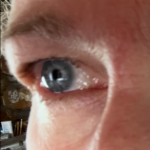 Sometimes seeing the person that is actually standing in front of me – rather than the person I wish were there – feels like standing in the rain with a painting I spent my whole life perfecting, watching all the colors run down my legs and into the street.
Sometimes seeing the person that is actually standing in front of me – rather than the person I wish were there – feels like standing in the rain with a painting I spent my whole life perfecting, watching all the colors run down my legs and into the street.
It is an experience of grief.
Many of us could use some exercise around reconciliation of humans, even though it can be excruciating. Sometimes the reconciliation can be required for a spouse or a parent – or even a child. Sometimes, it is articulating that a job you’ve longed for isn’t sustainable, isn’t as described, or is tainted by a boss who feels ogre-like.
Many of us, especially in the nonprofit and fundraising worlds, have some Pleaser saboteur in us. By definition, we have deep reservoirs of hope and idealism. We have it in our DNA, some of us, to see people as good, to look for their shiny and their silver linings. And many of us don’t like rocking the boat, so we make excuses or silently endure the parts of others that are jagged or mean.
Something true about me: I have always been a person who sees the light in others – and I actually love this about myself. But where I get into trouble is when I take only that light – you know, the best 10 seconds ever – and I extrapolate it into a whole person. It’s a form of fantasy, I know, born from some brilliant needs-must space from childhood.
But it turns out to be dangerous. Because even though I want to feel protected, special, immune to others’ bad behavior in relationships, it turns out that if I were seeing – rather than hoping or wanting – I would see that people are who they are: not just one thing. Not only the sum of their 10 best seconds. They are, in fact, capable of critical and mean and abuse, they can abandon suddenly and completely, they can lash out. They can deeply lack the capacity or the willingness to care or to hold – or to warn you to fasten your seatbelt before driving into the embankment. And those lacerating traits can exist side by side with generosity, charisma, joy and aliveness. It can be confusing.
For almost 12 years, I had an incredible dog named Tosha. She was chill and a delight, emotionally astute to the moods of her people, with fur that never failed to soothe. And then, she’d meet another dog she didn’t like, and she’d become a beast: vicious, drawing blood, going for the throat. And somehow, I could hold that all these versions of her were real, were all contained in that lithe herding body.
Why is that so hard with humans? What compels us to see only the fur but not the fangs in other people? And whether I see or choose not to, those teeth are sharp when they connect. And that is true in both dogs and people: sometimes, there’s no malice; they are simply doing them.
What is possible when I look down into the brown puddle of paint where reconciliation is born? What happens when I am willing to see clearly? When I am ready to risk disappointment?
For a start, there’s no fresh despair time after f*cking time, born of disbelief. I start believing in what is. There is space to step past the bleeding and learn to set better boundaries, to see things sooner – sometimes to bite back. There’s space for truth. There is space to feel less hurt.
There is space to let people be their own colors, to show up in their own palette. There is space to take it less personally.
There is potential for acceptance, for a new way to cultivate something that gets a lot closer to unconditional. To strengthen that part of my heart I don’t want to quiet, to see light and shadow both, and love anyway.
And there is also the invitation to say No, thank you. And walk away, without taking it personally, and with my throat uncut.
*These are learnings for me that have been possible since I got to know and understand the impact of my Pleaser, a saboteur I identified while going through the Positive Intelligence program. Interested in what you can learn about yourself from getting to know your saboteurs? Fundraising Leadership would love to help.
Blog by Fundraising Leadership team member Margaret Katz Cann.